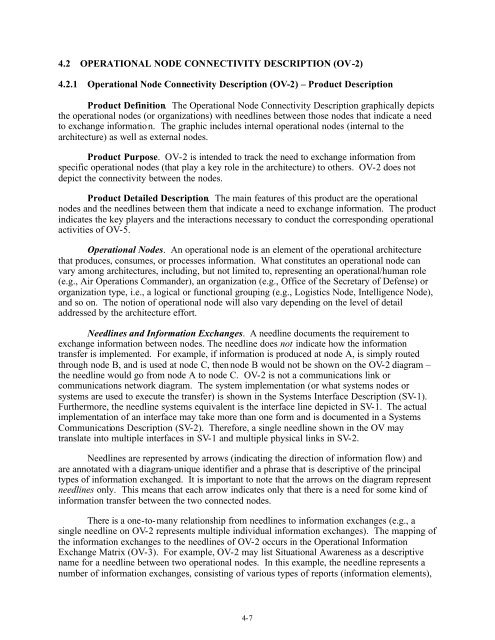DoD Architecture Framework Version 1.0, Volume 2 - AcqNotes.com
DoD Architecture Framework Version 1.0, Volume 2 - AcqNotes.com
DoD Architecture Framework Version 1.0, Volume 2 - AcqNotes.com
You also want an ePaper? Increase the reach of your titles
YUMPU automatically turns print PDFs into web optimized ePapers that Google loves.
4.2 OPERATIONAL NODE CONNECTIVITY DESCRIPTION (OV-2)4.2.1 Operational Node Connectivity Description (OV-2) – Product DescriptionProduct Definition. The Operational Node Connectivity Description graphically depictsthe operational nodes (or organizations) with needlines between those nodes that indicate a needto exchange information. The graphic includes internal operational nodes (internal to thearchitecture) as well as external nodes.Product Purpose. OV-2 is intended to track the need to exchange information fromspecific operational nodes (that play a key role in the architecture) to others. OV-2 does notdepict the connectivity between the nodes.Product Detailed Description. The main features of this product are the operationalnodes and the needlines between them that indicate a need to exchange information. The productindicates the key players and the interactions necessary to conduct the corresponding operationalactivities of OV-5.Operational Nodes. An operational node is an element of the operational architecturethat produces, consumes, or processes information. What constitutes an operational node canvary among architectures, including, but not limited to, representing an operational/human role(e.g., Air Operations Commander), an organization (e.g., Office of the Secretary of Defense) ororganization type, i.e., a logical or functional grouping (e.g., Logistics Node, Intelligence Node),and so on. The notion of operational node will also vary depending on the level of detailaddressed by the architecture effort.Needlines and Information Exchanges. A needline documents the requirement toexchange information between nodes. The needline does not indicate how the informationtransfer is implemented. For example, if information is produced at node A, is simply routedthrough node B, and is used at node C, then node B would not be shown on the OV-2 diagram –the needline would go from node A to node C. OV-2 is not a <strong>com</strong>munications link or<strong>com</strong>munications network diagram. The system implementation (or what systems nodes orsystems are used to execute the transfer) is shown in the Systems Interface Description (SV-1).Furthermore, the needline systems equivalent is the interface line depicted in SV-1. The actualimplementation of an interface may take more than one form and is documented in a SystemsCommunications Description (SV-2). Therefore, a single needline shown in the OV maytranslate into multiple interfaces in SV-1 and multiple physical links in SV-2.Needlines are represented by arrows (indicating the direction of information flow) andare annotated with a diagram-unique identifier and a phrase that is descriptive of the principaltypes of information exchanged. It is important to note that the arrows on the diagram representneedlines only. This means that each arrow indicates only that there is a need for some kind ofinformation transfer between the two connected nodes.There is a one-to-many relationship from needlines to information exchanges (e.g., asingle needline on OV-2 represents multiple individual information exchanges). The mapping ofthe information exchanges to the needlines of OV-2 occurs in the Operational InformationExchange Matrix (OV-3). For example, OV-2 may list Situational Awareness as a descriptivename for a needline between two operational nodes. In this example, the needline represents anumber of information exchanges, consisting of various types of reports (information elements),4-7

















